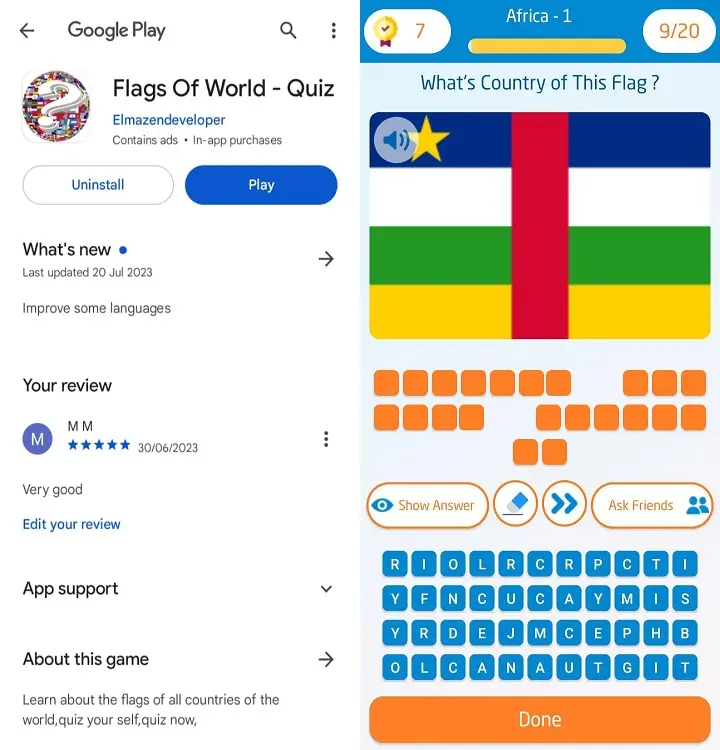Flag of the Central African Republic
Central African Republic: a hidden gem in the heart of the African continent
Discover the Central African Republic: Borders, Population, Flag, Currency, Economy, Landmarks, Capital.
Borders of the Central African Republic
The Central African Republic (CAR) is a landlocked country located in the heart of the African continent.
It is bordered by Chad to the north, Sudan to the northeast, South Sudan to the east, Cameroon to the west, and the Democratic Republic of the Congo to the south.
Covering an area of approximately 622,984 square kilometers, CAR is roughly the size of the US state of Texas.
The country is known for its rich natural resources and its diverse ecological and cultural heritage.
Flag of the Central African Republic, Currency, Population, Tourist Places

Download the application  Flags Of World - Quiz ,
Flags Of World - Quiz ,
And test your knowledge with Flags of World ,
Population of the Central African Republic
According to the World Bank, the population of the Central African Republic was estimated at approximately 5.44 million as of February 2025, with an annual population growth rate of 1.8%.
The Bayaka people form the majority, comprising several subgroups that speak various languages and dialects.
Other ethnic groups include the Banda, Mandjia, Sara, Mbaka, and Fulani.
The official languages of the country are French and Sango.
However, more than 80 local languages are spoken across the nation, reflecting its rich cultural diversity.
Flag of the Central African Republic
The flag of the Central African Republic consists of four horizontal stripes in blue, white, green, and yellow, with a vertical red stripe in the middle.
Each color carries a significant meaning:
Blue: Symbolizes the sky, peace, and the unity of the people.
White: Represents dignity and purity.
Green: Stands for the country’s forests, agriculture, and hope.
Yellow: Reflects the savannah, the sun, and the nation’s wealth.
Red: Embodies the blood shed for independence and the sacrifices of the martyrs.
The flag was adopted in 1958 when the Central African Republic became an autonomous territory within the French community.
Its design combines traditional African colors with those of the French flag.
Flag of the Central African Republic, Currency, Population, Tourist Places

Download the application  Flags Of World - Quiz ,
Flags Of World - Quiz ,
And test your knowledge with Flags of World ,
Currency of the Central African Republic
The official currency of the Central African Republic is the Central African CFA franc (XAF), pegged to the euro at a fixed exchange rate of 655.96 francs per euro.
This currency is also used in five other countries that are part of the Central African Economic and Monetary Community (CEMAC), including Cameroon, Chad, Congo, Equatorial Guinea, and Gabon.
The CFA franc was first issued in 1945 when CAR was still a French colony.
The name stands for "Communauté Financière d’Afrique" (Financial Community of Africa).
Economy of the Central African Republic
The economy of the Central African Republic largely relies on subsistence agriculture, logging, and mining.
The country is a major exporter of diamonds, gold, timber, cotton, and coffee.
Despite its abundant resources, the economy faces numerous challenges, including political instability, poor infrastructure, and environmental issues.
Tourist Attractions in the Central African Republic
Despite its challenges, the Central African Republic is home to numerous breathtaking tourist destinations that showcase its natural beauty and cultural heritage:
Manovo-Gounda St. Floris National Park
Designated as a UNESCO World Heritage Site, this park is one of the largest and richest protected areas in Africa, covering over 17,000 square kilometers.
The park hosts a wide variety of wildlife, including elephants, lions, leopards, cheetahs, rhinos, hippos, crocodiles, antelopes, and numerous bird species.
It also contains archaeological sites dating back to the Neolithic era.
Dzanga-Sangha Special Reserve
Located in the southwest near the borders of Congo and Cameroon, this reserve is part of the Sangha Tri-National Park shared by the three countries.
Dzanga-Sangha is home to rare species such as gorillas, chimpanzees, forest elephants, and bongo antelopes.
It also offers eco-tourism opportunities, including hiking, canoeing, fishing, and cultural visits to local pygmy communities.
Capital of the Central African Republic
Bangui, the capital and largest city of the Central African Republic, lies on the banks of the Ubangi River, forming the border with the Democratic Republic of the Congo.
The city is known for its vibrant atmosphere and its mix of colonial and modern architecture.
Key landmarks in Bangui include the Bangui Cathedral, the National Museum, the Presidential Palace, the Central Mosque, and the unique circular-shaped Bangui M’Poko International Airport.
Boali Falls
Located about 85 kilometers northwest of Bangui, near the town of Boali, these stunning waterfalls are formed by the Mbali River cascading from a cliff about 50 meters high and 250 meters wide.
Boali Falls is a popular spot for picnics and relaxation, offering spectacular views, refreshing mist, and occasional rainbows created by the sun’s reflection.
Visitors can also tour the nearby hydroelectric dam that supplies power to the region.
Conclusion
The Central African Republic is a country full of natural beauty and cultural diversity, making it an ideal destination for travelers seeking adventure and discovery.
Despite its ongoing challenges, CAR has immense potential awaiting support and investment to achieve peace and development.
The Central African Republic deserves a chance to showcase its remarkable heritage, abundant resources, and rich history to the world.
Flag of the Central African Republic, Currency, Population, Tourist Places
